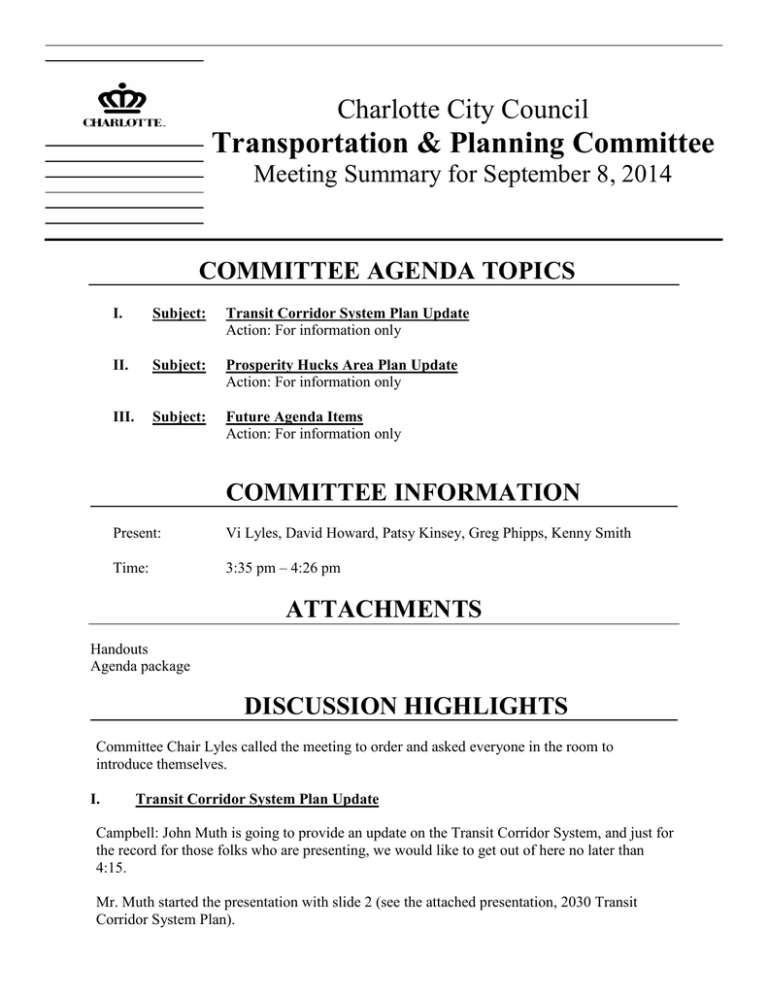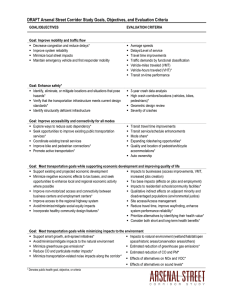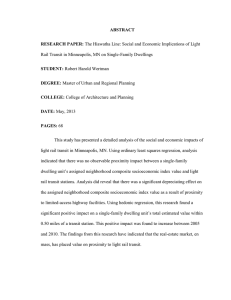Transportation & Planning Committee Charlotte City Council
advertisement

Charlotte City Council Transportation & Planning Committee Meeting Summary for September 8, 2014 COMMITTEE AGENDA TOPICS I. Subject: Transit Corridor System Plan Update Action: For information only II. Subject: Prosperity Hucks Area Plan Update Action: For information only III. Subject: Future Agenda Items Action: For information only COMMITTEE INFORMATION Present: Vi Lyles, David Howard, Patsy Kinsey, Greg Phipps, Kenny Smith Time: 3:35 pm – 4:26 pm ATTACHMENTS Handouts Agenda package DISCUSSION HIGHLIGHTS Committee Chair Lyles called the meeting to order and asked everyone in the room to introduce themselves. I. Transit Corridor System Plan Update Campbell: John Muth is going to provide an update on the Transit Corridor System, and just for the record for those folks who are presenting, we would like to get out of here no later than 4:15. Mr. Muth started the presentation with slide 2 (see the attached presentation, 2030 Transit Corridor System Plan). Transportation & Planning Committee Meeting Summary for September 8, 2014 Page 2 of 6 Howard: One of the reasons this subject is important to me is to make sure we’re clued in on not only what’s going on with construction projects but the money. Is there anything going in right now that’s turning in the wrong direction that we need to know about? Muth: No. We feel like we’re in good shape relative to budget. The civil contracts combined with the track contract that you awarded earlier this year came in $62 or $63 million under what had been budgeted. Our contingency right now is significantly greater than the FTA would have required as a minimum. We will keep you updated on schedules and any budget issues. Howard: I’d love to have an update slide with a broad category as to where you are from a budget perspective. Muth: I think you all get the monthly reports emailed to you. Lyles: I don’t think so. Muth: This is the monthly report we prepare for the FTA. It has a lot of information about the budget. We’ll check on that. Howard: It might be part of the MTC packet we get. Muth: It might be. I’ll check and if you’re not getting it, I’ll make sure you do. It’s good information. Smith: If it’s part of a larger package, can you separate it out and send it? Muth: Yes. Lyles: Mr. Howard, I think we talked about getting a bi-monthly update. The point is to have something that highlights what’s in the document. Howard: Having that information ahead of time would be helpful. Muth: Okay. Phipps: What are the projected completion dates for the Eastway Bridge lengthening, 36th Street grade separation and Sugar Creek grade separation projects (see slide 6 of the attached 2030 Transit Corridor System Plan)? Muth: I’m not sure but I’ll get that information to you. Lyles: That would be great. Email is fine. Mr. Muth resumed the presentation with slide 8 (see the attached presentation, 2030 Transit Corridor System Plan). Transportation & Planning Committee Meeting Summary for September 8, 2014 Page 3 of 6 Howard: How much was the Tiger Grant (see slide 8 in the attached presentation, 2030 Transit Corridor System Plan)? Muth: I think $18M. Howard: I’d love to know how much each station costs and how much is left. Muth: Okay. Mr. Muth resumed the presentation with slide 9 (see the attached presentation, 2030 Transit Corridor System Plan). Smith: Help me understand the difference between commuter rail and light rail. Muth: Light rail is powered overhead by electrical power. It’s typically in the 18-15 mile range, and some places might go out 20 miles. Station spacing is about a quarter of a mile close in, and maybe one-half mile to a mile as you get further out. We have fifteen stations on our 9.5 mile light rail. Commuter rail can be electric power as well, but we have talked about a diesel locomotive with three or four passenger cars attached to it. Station spacing is about five miles or greater. The longer distances would typically be served by commuter rail that serve primarily during peak periods, so less frequent service than a light rail project. Also, a commuter rail can operate on freight tracks with an agreement. The light rail has to be on its own tracks. Mr. Muth resumed the presentation with slide 10 (see the attached presentation, 2030 Transit Corridor System Plan). Phipps: Is the Red Line truly a viable line given the lack of consensus with the towns and the issue with Norfolk Southern? I know we’ve kept it as part of the plan, but is it really viable? Lyles: Mr. Howard would like to address that question. Howard: The towns were fighting for this and were ready to kill the Blue Line Extension. They want the Red Line very much, and everyone is working to find an arrangement with Norfolk Southern and the North Carolina Railroad. It’s the only way to feed mass transit going north. You can tell by what you see on TV about Hot Lanes; they need other ways to get from the north into Charlotte. Lyles: This is our only connection to the north. When do we get to talk about when the Blue Line continues south? Howard: I’ll let you know tomorrow. This whole system was designed as a regional system. It’s time to start having that conversation with the towns to get the counties together. Mr. Muth resumed the presentation with slide 11 (see the attached presentation, 2030 Transit Corridor System Plan). Transportation & Planning Committee Meeting Summary for September 8, 2014 Page 4 of 6 Smith: When you say, “Coming down Monroe,” do you mean down the middle of the road or down existing tracks? Muth: If it’s a streetcar, it has to go down middle of Monroe road. It wouldn’t be compatible with the CSX freight tracks. Mr. Muth resumed the presentation with slide 13 (see the attached presentation, 2030 Transit Corridor System Plan). Lyles: When would Council begin to see this shaping up for a decision (see slide 13 of the attached presentation, 2030 Transit Corridor System Plan). Muth: We’d like to purchase the Greyhound and bring it to you for consideration later this year or early next year. Lyles: I thought we had to do something before the end of this year. Muth: We need to show FTA that we have a viable plan and show that we have elected officials behind the project and show commitment from the state to working out the track issues with Norfolk Southern. We just need to show the plan. Buying the Greyhound property is an acceptable use of the funds. We made a previous offer and that now needs to be updated. Howard: Are you two talking about the same thing? You were talking about the money can go back? Lyles: We are talking about the money that can go back as well. Muth: There has been no firm date given to us. Howard: How much could go back? Muth: We have about $18M that hasn’t been spent. Howard: Buy it. Muth: Greyhound is interested in what the long term plan is before they agree to a commitment so we’ve got to work through those issues with them. Mr. Muth concluded the presentation with slide 15 (see the attached presentation, 2030 Transit Corridor System Plan). Lyles: Thank you. We’ll see you in about 8 weeks. Campbell: When we come back we’d like to ask the Committee to focus on the most specific information you can so that we aren’t being redundant every other month. We want to bring new information. Transportation & Planning Committee Meeting Summary for September 8, 2014 Page 5 of 6 Howard: I want to hear more definition about what’s happening with the Gateway Station. Muth: Okay. The path we’re talking about is the state being in the lead working out the track requirements, and the city being the lead on developing the property. Lyles: The next item is the Prosperity Hucks update. II. Prosperity Hucks Area Plan Update Campbell: This is just for information to update you on where we are. Ed, I’ll turn it over to you. Mr. McKinney started the presentation with slide 3 (see attached presentation, Prosperity Hucks Area Plan). Phipps: I want to applaud the work that staff is doing. I don’t know that we’ll easily reach an agreement because of the apartment phase of it. They think it will take up a lot of acreage they feel would be conducive to an activity center. I think it’s been worth it. Howard: I would love to know if staff has taken the time to find out what went wrong with this one. Are there lessons learned that allow us to understand why this took an extra year. Campbell: I would not describe this as something going wrong. I would describe this as something we needed to do to better clarify what the vision was. When you use the terminology village or activity center, lots of things are conjured up in your mind. In the document or in the text of the plan, I don’t think we did a good job of defining the features and characteristics so that the document describes what those characteristics are. Also, we haven’t necessarily gotten away from the fundamental thought process of creating this special and unique place, because development has occurred that is inconsistent with that vision. We are trying to figure out how we truly capture the essence of the 1998 plan and we have to react to the existing plan. I think we’ve gained a lot more credibility with the neighborhood, but I also think they understand that we are going to disagree on some things particularly related to housing diversity. Howard: I didn’t mean it went wrong as much I wonder what happened. What concerned me are the people who had to sit through it the first time having to start over. How does that work with this new group being added the process? Campbell: Nothing stimulates community interest in a planning process more than a rezoning. Lyles: Thank you. It’s a lot of work. Campbell: Kudos to my staff because they have truly been patient getting community input. It’s not easy. III. Future Agenda Items Transportation & Planning Committee Meeting Summary for September 8, 2014 Page 6 of 6 Lyles: Regarding the last agenda item (Future Agenda Items) I think we’ll start with the top two items unless there is something specific you want to move up on the list. Phipps: You may have received the same email I did from Martin Zimmerman regarding parking near colleges and universities, so I hope we’ll be able to move that item up. Lyles: Can we look at parking near colleges? Campbell: We will look at it and communicate with the chair about the next steps. Lyles: Any other items? Campbell: Welcome back from your summer vacation. You’ve got a lot on your plate as you can see from the referrals, and we’re looking forward to working with you. Meeting adjourned at 4:26. 9/9/2014 Transportation and Planning Committee September 8, 2014 2030 Transit Corridor System Plan 1 9/9/2014 Project Overview • • • • • • • • • • • 9.3 miles, 11 stations 4 park and ride facilities Approx. 3,100 parking spaces Accommodates 3-car trains 25,000+ daily riders Improvements to North Tryon St. Connects UNC Charlotte campuses 22 minute commute from Uptown to UNC Charlotte Initial service 7.5 minute peak frequency Connecting bus services Revenue service in 2017 Advanced Utility Relocation Civil Construction Expected Completion: August 2014 Started: March 2014 Track and Systems Construction Started: July 2014 2 9/9/2014 What’s happening out there? • • • • • Utility relocation, both above and underground Retaining walls to support the widened roadway Widening the road to make room for light rail tracks Adding light rail tracks along existing freight tracks Lengthening the Eastway bridge to accommodate tracks underneath Construction Impacts North Tryon Street construction starts this summer • Maintenance of traffic during • construction will be an area of focus for CATS, NCDOT and CDOT. • • Traffic shifts will occur for construction; the traveling public • should allow extra travel time. • BLE Communications Team has a robust communication plan to announce changes to traffic patterns. Businesses will retain access during construction. Pedestrian access will be maintained during construction. Areas of particular concern: o NCDOT Mallard Creek bridge replacement o Eastway Bridge lengthening o 36th Street grade separation o Sugar Creek grade separation 3 9/9/2014 Partnerships are Key! Supporting Businesses, Residents, Community Strong communication at all levels will ensure the BLE’s successful completion • Points of contact o Business Liaison o Community Specialist • Multi-departmental agency coordination • Collaboration o Joint BLE Communications Team o Residents and Business Owners o Non-profits o First Responders, CMC, CMS, UNC Charlotte o Media LYNX Blue Line Capacity Expansion o Funded by Transportation Investment Generating Economic Recovery (TIGER III) o Expand three platforms to accommodate 3-car trains o Request made to FTA to extend platforms at fourth station o Add 4 traction power substations (TPSS) o Will pursue Core Capacity Grant to extend remaining platforms 4 9/9/2014 CityLYNX Gold Line Phase 2 Red Line (Commuter Rail) • Commuter rail to northern towns • Currently not eligible for federal funding grants • NCDOT participation necessary o Financial partners o Leadership with private railroads • Norfolk Southern owns O‐Line corridor • O‐Line is a strategic corridor • NS needs permanence on NCRR • NS has not agreed on project scope • Candidate for P3 design‐build 5 9/9/2014 Southeast Corridor ‐ Key ULI Recommendations Limited Access Express Way BRT/Express Bus Street Car Local/Feeder Bus • • • BRT/Express bus on Independence in HOT lanes Streetcars on Central and Monroe Promote auto‐oriented retail on Independence and neighborhood serving, mixed‐use development on streetcar lines Southeast Corridor Alignment Definition Goals and Timeline Goals • Define a fixed guideway alignment that serves future transportation needs and promotes the land use plans and polices of the Southeast Corridor. • Provide interim transit strategy that utilizes the future HOT lane proposed on Independence Blvd. • Coordinate with land development strategies to protect and preserve the fixed guideway alignment. FY 15 – FY 16 • The project team will take into consideration past studies with an open approach and “fresh look” • Final recommendations to MTC in FY 16 6 9/9/2014 Charlotte Gateway Station – Connecting The Region’s Public Transportation Project Site 7 9/9/2014 West Corridor 2025 System Plan (2002) • Bus Rapid Transit • Light rail not FTA cost‐effective 2030 System Plan (2006) • Streetcar extension– post 2030 • Light rail not FTA cost‐effective Airport Strategic Development Plan • Articulation of the Airport’s role in global marketplace • Framework for Land Development that drives economic growth Thank You City of Charlotte 8 3/12/2015 Update: Prosperity Hucks Area Plan Draft Plan Review & Refinement: Steps we are taking 1. Community Dialog 2. Redefine the Activity Center 3. Refine land use & design recommendations 4. Plan Review & Adoption 1 3/12/2015 Community Dialog: March 27th - Meeting @ Oehler Barn May 13th – Core Group meeting 21st – Core Group meeting June Recent activity Spring – Summer 2014 11th-12th – Small Group Discussions (6 meetings in small groups, totaling 70+ participants) August 5th – Core Group meeting 20th – Core Group meeting September 3rd – Core Group meeting Upcoming 16-17th – Small Group Work Sessions 23rd – Public Summary Review Community Dialog: Lots of Ideas & Issues… 4 2 3/12/2015 Community Dialog: Homework images… 5 Redefining the Activity Center Prosperity Ridge Road Prosperity Church Road Benfield Road I-485 Ridge Road I-485 6 3 3/12/2015 Redefining the Activity Center I-485 Prosperity Ridge Road Prosperity Church Road Benfield Road Ridge Road I-485 7 Redefining the Activity Center Prosperity Ridge Road Prosperity Church Road Benfield Road I-485 Ridge Road I-485 8 4 3/12/2015 Refine Land Use & Design: 1. What design characteristics do we want to encourage? 2. What is the form of retail/office/commercial we want? 3. Where is the place for multi-family? Questions to be Answered Plan Review & Adoption : 4. What type of open space do we want? September-October • Community work sessions & meetings • Recommendations Next Steps November-December • Update Draft Plan • Begin review & adoption process January-March • Complete public hearing & Council adoption process 5 Transportation & Planning Committee Monday, September 8, 2014 3:30 – 4:30 p.m. Charlotte-Mecklenburg Government Center Room 280 Committee Members: Vi Lyles, Chair David Howard, Vice Chair Patsy Kinsey Greg Phipps Kenny Smith Staff Resource: Debra Campbell, Planning Director and City Manager’s Office AGENDA I. Transit Corridor System Plan Update –30 minutes Staff Resource: John Muth, Transit Staff will present an update on the status of key elements of the 2030 Transit Corridor System Plan. Action: For information only II. Prosperity Hucks Area Plan Update –15 minutes Staff Resource: Ed McKinney Staff will present an update on the status of the Prosperity Hucks Area Plan. Action: For information only III. Future Agenda Items –15 minutes Staff Resource: Debra Campbell Staff will ask the Committee to identify items to be discussed at their next meeting. Action: Select agenda topics to be discussed at the next Committee meeting. • Walkability Scan/Pedestrian Safety • Development Review and Permitting Assessment • Auto Oriented Uses • Zoning Ordinance Update • Prosperity Hucks Area Plan • Parking near Colleges and Universities • University City Area Plan Next Scheduled Meeting: October 23, 2014 at 12:00 p.m. Distribution: Mayor & City Council Transportation Cabinet Ron Carlee, City Manager John Muth Executive Team Ed McKinney



